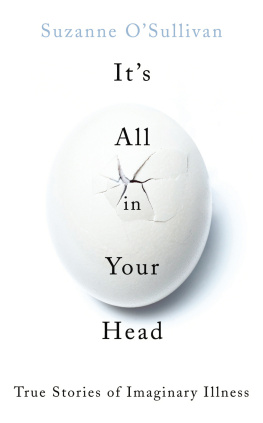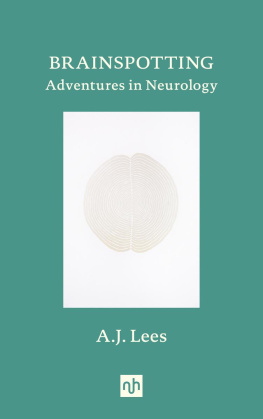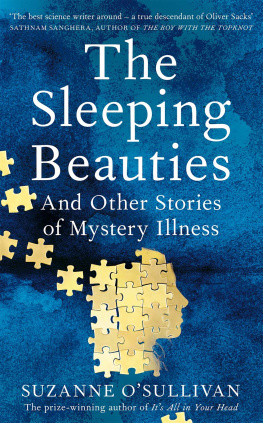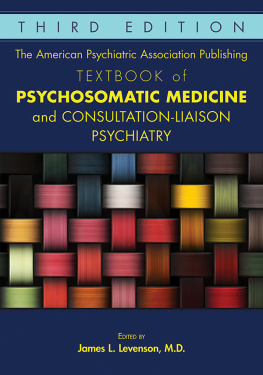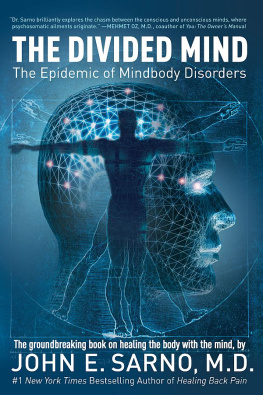Suzanne O’Sullivan - It’s All in Your Head: True Stories of Imaginary Illness
Here you can read online Suzanne O’Sullivan - It’s All in Your Head: True Stories of Imaginary Illness full text of the book (entire story) in english for free. Download pdf and epub, get meaning, cover and reviews about this ebook. year: 2015, publisher: Vintage Digital, genre: Science fiction. Description of the work, (preface) as well as reviews are available. Best literature library LitArk.com created for fans of good reading and offers a wide selection of genres:
Romance novel
Science fiction
Adventure
Detective
Science
History
Home and family
Prose
Art
Politics
Computer
Non-fiction
Religion
Business
Children
Humor
Choose a favorite category and find really read worthwhile books. Enjoy immersion in the world of imagination, feel the emotions of the characters or learn something new for yourself, make an fascinating discovery.
- Book:It’s All in Your Head: True Stories of Imaginary Illness
- Author:
- Publisher:Vintage Digital
- Genre:
- Year:2015
- Rating:3 / 5
- Favourites:Add to favourites
- Your mark:
- 60
- 1
- 2
- 3
- 4
- 5
It’s All in Your Head: True Stories of Imaginary Illness: summary, description and annotation
We offer to read an annotation, description, summary or preface (depends on what the author of the book "It’s All in Your Head: True Stories of Imaginary Illness" wrote himself). If you haven't found the necessary information about the book — write in the comments, we will try to find it.
It’s All in Your Head: True Stories of Imaginary Illness — read online for free the complete book (whole text) full work
Below is the text of the book, divided by pages. System saving the place of the last page read, allows you to conveniently read the book "It’s All in Your Head: True Stories of Imaginary Illness" online for free, without having to search again every time where you left off. Put a bookmark, and you can go to the page where you finished reading at any time.
Font size:
Interval:
Bookmark:

Contents
For E.H.
While I was convinced the woman was afflicted not by a bodily disease, but rather that some emotional trouble grieved her, it happened at that very moment I was examining her, this was confirmed. Someone coming from the theatre mentioned he had seen Pylades dancing. Indeed, at that instant, her expression and colour of her face was greatly altered. Attentive, my hand laid on the womans wrist and I observed her pulse was irregular, suddenly, violently agitated, which points to a troubled mind.
Galen, c. AD 150
I QUALIFIED AS a doctor in 1991. For fledgling doctors their first great dilemma comes when they are asked to choose their specialty. Some parts of the decision are easy. You either want to operate on people or you dont. You can react quickly in an emergency or you cant. Some want to be a scientist in a laboratory. Others would prefer to spend their time with patients. Medicine has room for every type of person. It is sometimes harder to make the more refined career decisions that follow. You know that you want to be a surgeon, but which bit do you want to operate on? Are you fascinated by the heart, where a single missed beat can put life in immediate peril? Or do you want to experience the highs and lows of the fight against cancer cells?
Despite all the possibilities, I knew from an early stage in my training what my decision would be. I wanted to be a neurologist. When I made that choice I thought I knew what it meant and where it would take me. I wanted to emulate the people I had learned from, the individuals who had inspired me. I enjoyed the detective drama of the job, unravelling the mysteries of how the nervous system communicates its messages, and learning all the things that can go wrong. Imagine a man who cannot move his right leg and cannot feel his left leg wheres the lesion? Whats the disease? Or a woman who is otherwise well but finds she cant write and cant identify her fingers. Ask her to say which is the index finger and she will not get it right. What part of the brain, when damaged, causes that? Neurological disease manifests in elusive and strange ways. There is a sort of epileptic seizure that is triggered by brushing your teeth. There are strange temporary paralytic disorders that strike after eating salty food.
I started my first training post in neurology in 1995, expecting to look after people who had diseases of the brain and nerves and muscles; conditions like multiple sclerosis, stroke, migraine and epilepsy. I could not have predicted how far I would find myself drawn into the care of those whose illness originated not in the body, but in the mind.
Examples of how the mind affects the body are everywhere. Some are so commonplace that they are not regarded as anything out of the ordinary. Tears are only salt water produced by ducts in the eye. They are a physiological response to a feeling. I cry if I feel sad, but happiness can have exactly the same effect. Sometimes tears are triggered by a memory or a piece of music or a painting. They occur in response to anger or laughter. The instantaneousness of it all has always amazed me.
The body has a multitude of ways through which it can express emotion. Blushing occurs when the blood vessels of the head and neck dilate and become infused with blood. It is an instantaneous physical change seen on the surface but reflecting a feeling of embarrassment or happiness that is held inside. When it happens I cant control it. That point is important. My blushes betray a feeling and, even when they increase my embarrassment, I cannot stop them.
Sometimes the bodys reactions are more dramatic than a brief blush or the odd tear. Even quite exaggerated bodily responses to emotion are easy to accept if the circumstances are right. In the early nineteenth century in Naples and Florence: A journey from Milan to Reggio the French novelist Stendhal described how he felt when he first encountered the great frescoes of Florence. I was seized with a fierce palpitation of heart, the wellspring of life was dried up within me, and I walked with a constant fear of falling to the ground. Perhaps what Stendhal described seems extreme to some of us, but to others it may seem absolutely obvious that, on the day one first encounters the frescoes of Giotto, ones legs will weaken and ones heart will miss a beat.
There are many modern examples of the tendency to collapse in response to excitement. Think of young people fainting at pop concerts, for example. Of course, many such collapses are easily explained by the physiology of the body. A young girl is overcrowded in intense heat, her blood vessels dilate to cool her, venous pooling draws her circulation downwards away from her head and, for just a moment, her brain is deprived of oxygen, she collapses and consciousness is lost. She has fainted due to nothing more than the bodys physical response to a physical trigger.
And yet when scientists examined just this phenomenon, they demonstrated that not every swooning, swaying teenager could be accounted for in this way. In 1995 the New England Journal of Medicine published an article in which young people who had collapsed at a music concert were interviewed. Of the 400 brought to medical attention, forty were examined. Sixteen of those forty lost consciousness in a faint that was felt to be entirely explained by physical triggers heat and dehydration leading to falling blood pressure, circulation drawn away from the brain and subsequent collapse. Others had panicked when they found themselves trapped in a crowd, leading to hyperventilation that constricted the blood vessels going to the brain and, again, a brief blackout followed. But the doctors also observed that not every collapse could be attributed to heat or dehydration or the crush of the crowd; some had occurred in the context of only one trigger: an overwhelming surge of emotion. An emotional collapse, with no physical cause to account for it.
Most of us readily accept these common phenomena. We are familiar with the shake in our hand as we pick up the pen to sign the marriage register or the bead of sweat on our brow as we stand up to give the presentation we do not want to give. These are the bodys physiological responses to stress. They serve a purpose even if that purpose is not always obvious. They belong to the impulse that made the cavemans heart beat faster so that he could run away from the woolly mammoth. But what if this type of normal physical response to emotion ceases to work properly? After all, every function of our body that supports us can malfunction. Any cell that is alive can overgrow so that tumours form. Or they can stop growing, as with hair loss, for example. Any chemical that is produced can be overproduced, or underproduced, as happens in the overactive or underactive thyroid gland. In just the same way, sometimes the physical response of our organs to stress goes too far. When that happens, something that was normal is no longer so and illness occurs.
The word psychosomatic refers to physical symptoms that occur for psychological reasons. Tears and blushing are examples of this, but they are normal responses that do not represent illness. It is only when psychosomatic symptoms go beyond the ordinary and impair our ability to function or endanger our health that illness results. Modern society likes the idea that we can think ourselves better. When we are unwell, we tell ourselves that if we adopt a positive mental attitude, we will have a better chance of recovery. I am sure that is correct. But society has not fully woken up to the frequency with which people do the opposite unconsciously think themselves ill. Certainly, there are several medical disorders that are already commonly associated with stress. Most of us know that stress puts our blood pressure up and makes us more vulnerable to stomach ulcers. But how many are aware of the frequency with which our emotions can produce serious disability where no physical disease of any sort exists to explain it?
Font size:
Interval:
Bookmark:
Similar books «It’s All in Your Head: True Stories of Imaginary Illness»
Look at similar books to It’s All in Your Head: True Stories of Imaginary Illness. We have selected literature similar in name and meaning in the hope of providing readers with more options to find new, interesting, not yet read works.
Discussion, reviews of the book It’s All in Your Head: True Stories of Imaginary Illness and just readers' own opinions. Leave your comments, write what you think about the work, its meaning or the main characters. Specify what exactly you liked and what you didn't like, and why you think so.

